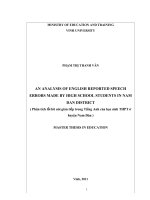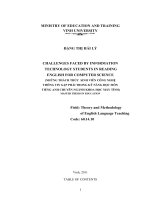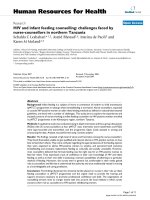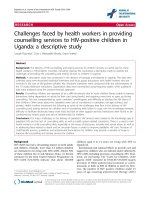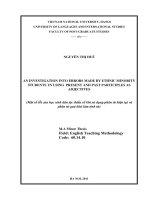Challenges faced by ULIS senior students in adapting teaching materials in ESP methodology subject
Bạn đang xem bản rút gọn của tài liệu. Xem và tải ngay bản đầy đủ của tài liệu tại đây (649.94 KB, 61 trang )
VIETNAM NATIONAL UNIVERSITY, HANOI
UNIVERSITY OF LANGUAGES AND INTERNATIONALSTUDIES
FACULTY OF ENGLISH LANGUAGE TEACHER EDUCATION
GRADUATION THESIS
CHALLENGES FACED BY ULIS SENIOR
STUDENTS IN ADAPTING TEACHING MATERIALS
IN ESP METHODOLOGY SUBJECT
Supervisor: Nguyen Thi Thanh Van M.Ed.
Student: Nhu Thu Sang
Course: QH2017. E6
HA NOI - 2021
ĐẠI HỌC QUỐC GIA HÀ NỘI
TRƯỜNG ĐẠI HỌC NGOẠI NGỮ
KHOA SƯ PHẠM TIẾNG ANH
KHÓA LUẬN TỐT NGHIỆP
KHÓ KHĂN SINH VIÊN NĂM CUỐI TRƯỜNG ĐẠI
HỌC NGOẠI NGỮ GẶP PHẢI TRONG QUÁ TRÌNH
THỰC HIỆN ĐIỀU CHỈNH TÀI LIỆU DẠY TRONG
MƠN PHƯƠNG PHÁP GIẢNG DẠY TIẾNG ANH
CHUYÊN NGÀNH
Giáo viên hướng dẫn: Th.s Nguyễn Thị Thanh Vân
Sinh viên: Nhữ Thu Sang
Khoá: QH2017.F1.E6
HÀ NỘI – NĂM 2021
DECLARATION
I herewith formally declare that I myself have written the thesis entitled
“Challenges faced by ULIS senior students in adapting teach material in ESP
Methodology subject” independently along with the guidance of my supervisor. In
addition, the contributions of students and lecturers of FELTE, ULIS are involved.
Other sources of information have been used and acknowledged.
I also certify that all the data, figures, sources and literature used for the thesis have
been fully and properly cited.
Hanoi, May 2021
Submitted by,
Nhu Thu Sang
ACKNOWLEDGEMENTS
A completed study would not be done without any assistance. Therefore, the author
who conducted this research gratefully gives acknowledgement to their support and
motivation during the time of doing this research as a requirement of completing
this graduation thesis.
Initially, I would like to express my deepest gratitude to a number of people for
helping me to make this study. My deepest gratitude goes first to Nguyen Thi Thanh
Van, M.Ed., my supervisor, who supported and encouraged me generously
throughout this study. Without her excellent academic guidance and support, my
thesis would not have been completed.
My appreciation also extends to two ESP lecturers and around ninety seniors who
have helped me by involving in my collecting data step, which plays an essential
role in the research‟s findings.
Last but not least, I also wish to express my sincere thanks to my family, my best
friends and my boyfriend who constantly stayed by my side, encouraged and
assisted me in completing the research. Their kind help, care and motivation was the
source of my inspiration.
I
ABSTRACT
This research was conducted to investigate the extrinsic and intrinsic factors
impeding senior students when doing the adapting teaching materials assignment of
the ESP Methodology subject. Also, the deep roots and the solutions for these
difficulties were fully presented to provide an overview of the matter. The data in
the findings section were collected through document analysis, questionnaire and
interview with under 100 participants including 2 lecturers and around 80 seniors.
These instruments were used to gather and analyse the perception and notion of
both teachers and students towards these challenges.
The data analyses indicated that students appeared to confront more intrinsic
challenges than extrinsic ones. Most of them could individually identify the
problems themselves and figured out several feasible solutions. Additionally, from
the sharing of lecturers, the similarity in the viewpoint between teachers and
students could be seen obviously. Lastly, on the basis of data analysis and
discussion, some practical implications for further studies were also presented in
this field.
II
LIST OF TABLES AND FIRGURES
Figure 2.1.3: ELT Tree
Table 2.2.3: The ways to adapt the material
Figure 2.5: Framework of the study
Figure 4.1: The importance of materials in teaching an ESP course from the
perspective of senior students
Figure 4.1: The importance of teachers in preparing the materials for teaching an
ESP course
Table 4.2.1: Intrinsic and extrinsic challenges of ESP materials adaptation faced up
by senior students
Table 4.3.1: The causes of these difficulties from the perspectives of ULIS senior
students
III
ABBREVIATIONS
1. English for Academic purposes (EAP)
2. English for General Purposes (EGP)
3. English for Occupational Purposes (EOP)
4. English for Specific Purposes (ESP)
5. English language teaching (ELT)
6. Faculty of English Language Teacher Education (FELTE)
7. General English (GE)
8. SD (standard deviation)
9. University of Languages and International Studies (ULIS)
10. Vietnam National University (VNU)
IV
TABLE OF CONTENTS
DECLARATION
ACKNOWLEDGEMENTS
I
ABSTRACT
II
LIST OF TABLES AND FIRGURES
III
ABBREVIATION
IV
TABLE OF CONTENTS
V
CHAPTER ONE: INTRODUCTION
1
1.1. Background of the study
1
1.2. Statement of research problems and questions
2
1.3. Scope of the study
3
1.4. Significance of the study
3
1.5. Organization
3
CHAPTER TWO: LITERATURE REVIEW
2.1. English for specific purposes (ESP)
4
4
2.1.1. Definition of ESP
4
2.1.2. Characteristics of ESP
5
2.1.3. Categories of ESP
6
2.2. ESP material adaptation
8
2.2.1. What are materials in ESP?
8
2.2.2. What is ESP material adaptation?
9
2.2.3. Methods of ESP material adaptation
10
2.3. Challenges in adapting ESP materials
12
2.4. Challenges faced by senior student when
12
practicing adapting the materials as a task in class.
2.5. Framework of the study
13
V
CHAPTER THREE: METHODOLOGY
3.1. Context of the study
14
14
3.1.1. Description of ESP Methodology course
14
3.1.2. Description of ESP task
14
3.2. Participants
14
3.2.1. Seniors students of FELTE, ULIS,VNU
14
3.2.2. Lecturers of FELTE, ULIS,VNU
15
3.3. Data collection procedure
15
3.4. Data collection instrument
15
3.4.1. Questionnaire
15
3.4.2. Interview
16
3.4.3. Document
17
3.5. Data analysis procedure
17
CHAPTER FOUR: FINDINGS AND DISCUSSION
18
4.1. Background of the role of material adaptation in ESP
18
4.2. Question 1: What are the challenges faced by senior
21
students when adapting the materials?
4.2.1. Students‟ questionnaire analysis
21
4.2.2. Students‟ interview analysis
24
4.2.3. Lecturers‟ interview analysis
26
4.3. Question 2: What are the causes of these difficulties
27
from the perspectives of ULIS students and lecturers?
4.3.1. Students‟ questionnaire analysis
27
4.3.2. Students‟ interview analysis
29
4.3.3. Lecturers‟ interview analysis
30
4.4. Question 3: What are some possible solutions for
31
these challenges?
4.4.1. Students‟ interview analysis
VI
31
4.4.2. Lecturers‟ interview analysis
32
CHAPTER FIVE: CONCLUSION
34
5.1. Research summary
34
5.2. Recommendations
37
5.2.1. Recommendations for ESP lecturers
39
5.2.2. Recommendations for senior students
39
5.2.3. Recommendation for the ESP Methodology
program in ULIS
39
5.3. Limitations of the study
39
5.4. Suggestions for further studies
40
REFERENCE
41
APPENDIX A: Consent form
43
APPENDIX B: Questionnaire
45
APPENDIX C: Interview Protocol
49
VII
CHAPTER ONE
INTRODUCTION
1.1. Background of the study
In the integrated community these days, the requirement of using English is
essential due to its role as an international language among a number of countries.
This role apparently results in the contribution of many aspects including science,
technology, education, employment and so on (Rao, 2019, p72). In this sense, this
foreign language is regarded as a “common medium of communication” and “an
access to much scientific and technical literature” (Kennedy et al.,1984).
Consequently, there is a significant growth in the position of English over time.
Along with the sustainable development of English, its numerous functions
have been utilized for specific purposes, in particular areas, which is regularly
known as English for Specific Purposes (ESP). Hutchinson and Waters (1987)
illustrated that ESP is opposed to General English (GE); it is teaching English for
any other purposes based on the learners' needs. In this case, learners need to study
English in order to meet the demand of their work or study (Robinson, 1991:2).
Since the first emergence in the 1960s, it has fast “become fashionable in the
language- teaching world” (Haddam, 2015, p.18). From that time, English has been
used as a tool serving the purposes of many generations. However, the more needs
for ESP in the labor market is, the more attention needs to be paid on the quality of
teaching procedure. The challenge stems from the lack of sufficient training for ESP
teachers who shifted from the English language teaching (ELT) area (Pham & Ta,
2016).
Mentioning difficulties faced by ESP practitioners, Dudley-Evans & St. John
(1998) have identified some specific roles of an ESP practitioner as a teacher,
course designer and material provider, collaborator, researcher and evaluator, which
is quite different from GE teacher. ESP teachers have to figure out the material,
carry out adaptation and design a separate course which is based solely on the
1
learners‟ factors including their level, aim, background and needs. These tasks
require ESP practitioners to extend their linguistic and academic knowledge as well.
Up to now, there are several researches analysing the challenges for ESP
practitioners in teaching ESP. Specifically, the research of a group of students from
Hung Vuong University demonstrated the difficulties in teaching ESP for thirdyear students. The basic cause is mainly related to the unsuitable material which
shows little fit with learners‟ cognitive level.
1.2. Statement of research problems and questions
Although there are numerous projects and researches studying the difficulties
of ESP teaching progress, the number of studies analysing thoroughly the
challenges in adapting materials are much fewer. And even fewer products for
senior ELT students are recorded.
In Vietnam, it seems that there is little focus on senior ELT students due to
its minor effects. In the ESP Methodology course, as the role of both senior student
and researcher, the author is aware of considerable challenges facing all of them. As
a result, the research named “Challenges faced by ULIS senior students in
adapting teach material in ESP Methodology subject” is conducted with a view
to illustrating and analysing deeply about this term, which may be beneficial to the
next generations and teachers as well.
In this study, the following questions will be answered:
1. What are the challenges faced by senior students when adapting the teaching
materials in ESP Methodology course?
2. What are the causes of these difficulties from the perspectives of ULIS
students and lecturers?
3. What are some possible solutions for these challenges?
2
1.3. Scope of the study
The research solely focuses on the material adaptation of the whole ESP
teaching progress encountered by senior students of Faculty of English Language
Teacher Education (FELTE), University of Languages and International Studies
(ULIS), Vietnam National University (VNU). The research will be conducted based
on the viewpoints of four- year students who have experienced this subject, along
with the opinions of 2 ESP teachers. Therefore, the figures and results would show
significant reliability.
1.4. Significance of the study
This research provides the current issues with collected figures so that
feasible suggestions would be put forward.
The research includes a list of latest findings to the limit literature review
about senior students‟ tackling adapting materials in ESP Methodology subject.
Also, it will go deeply to demonstrate which specific factors lead to the difficulties
of students and the reason why students find them challenging. From that, learners
of this course could identify the problems and possibly solve them individually.
What‟s more, the study performs as a notice for ESP lecturers to comprehend
the current state so that they could make necessary adaptation to reduce the struggle
in the next ESP course.
Last but not least, the research is beneficial to all the senior students
especially who may participate in conducting the study. They would all be aware of
the matter, how it is challenging for both teachers and students in adapting future
ESP materials. So, with the provided feasible solutions, they could apply to
experience the effectiveness of them and lessen the struggles.
1.5. Organization
There are five chapters in this research:
3
Chapter one presents the Introduction of the study which includes the
background of the study, statement of problem, scope of study and the significance
of this work.
Chapter two is the Literature review part, which displays the theory of ESP
course and adapting ESP materials. The findings about challenges faced by senior
students when adapting the materials would be demonstrated as well, so as to create
a base for further research and discussion.
Chapter three displays the Methodology. It consists of 3-4 methods that the
researcher will utilize along the progress of conducting the research.
Chapter four provides the results collected from researching sources, the
discussion around the findings and states the answers for the research questions.
Chapter five concludes the research that will summarize all the content and
show the reference resources.
CHAPTER TWO
LITERATURE REVIEW
2.1. English for specific purposes (ESP)
2.1.1. Definition of ESP
The origin of ESP can be tracked as far back as the Greek and Roman
empires (Dudley –Evans and ST Johns, 1998:11). There have been a number of
states and theories related to the definition of this term.
According to Hutchinson and Waters (1987), ESP is a branch of English
Language Teaching (ELT), which is an approach to teach and learn English based
on learners‟ needs. The notion of ESP was also clearly stated by Hutchinson and
Waters (1987:19) who theorize: “ESP is an approach to language teaching in which
all decisions as to content and method are based on the learner‟s reason for
learning”
4
Harmer (1983) states that the definition of ESP has a slight difference from General
English. ESP can be viewed as a special and specific edition of English for General
Purposes (EGP) that incorporates practical linguistic skills to enable students for the
successful performance of professional tasks (Potocar, 2002)
Once again, the rationale of an ESP course is based firmly on learners‟ needs
analysis process. In conclusion, ESP basically follows the principle: “Tell me what
do you need English for, I will tell you the English you need”. (Bensafa, 2016)
2.1.2. Characteristics of ESP
ESP is a recognizable activity of English Language Teaching (ELT) with
some specific characteristics. Dudley-Evans and St. Johns tried (1998) to apply a
series of characteristics, some absolute and some variable, to outline the major
features of ESP.
a.
Absolute characteristics:
ESP is defined to meet specific needs of the learners;
ESP makes use of underlying methodology and activities of the discipline it
serves;
ESP is centered on the language (grammar, lexis, register), skills, discourse
and genre appropriate to these activities.
b. Variable Characteristics:
ESP may be related to or designed for specific disciplines;
ESP may use, in specific teaching situations, a different methodology from
that of General English;
ESP is likely to be designed for adult learners, either at a tertiary level
institution or in a professional work situation. It could, however, be for
learners at secondary school level;
ESP is generally designed for intermediate or advanced students. Most ESP
courses assume some basic knowledge of the language systems, but it can be
used with beginners.
(Dudley-Evans & St. John, 1998, p.4)
5
2.1.3. Categories of ESP
There were numerous attempts to classify ESP in various categories, and the
result was always a confusing demarcation of various subcategories and
abbreviations. Classically, ESP is categorized into two major branches. They are
English for Academic purposes (EAP) and English for Occupational Purposes
(EOP) (Strevens, 1977).
EOP is taught to those learners who will use their knowledge of language in
vocational field or profession. For example, EOP students can be journalists
or reporters or other technicians who may require English in their workplace
to prepare a news story, to shoot footage or to discuss with teammates.
English for Academic Purposes (EAP) is taught in academic institutions to
students who require English in their studies. The language covers a specific
area of higher education which the learner is studying or intends to study. As
a school subject, ESP flourishes both at the primary and secondary levels in
technical schools and non-technical sectors simultaneously.
Especially, in the ELT tree of Hutchinson & Waters (1987), there are some changes
in the division method, compared to the previous research.
6
Figure 2.1.3: ELT Tree (Hutchinson and Waters, 1987)
7
In the ELT Tree, the division is more specific, especially with ESP branch.
As can be seen in the Tree, ESP is differentiated with ELT branch. ESP is broken
down into three branches English for Science and Technology (EST), English for
Business and Economics (EBE), and English for Social Studies (ESS). Each of
these three subject is further divided into two branches: English for Academic
Purposes (EAP) and English for Occupational Purposes (EOP). An example of EOP
for the EST branch is 'English for Technicians' whereas an example of EAP for the
EST branch is 'English for Medical Studies'.
2.2. ESP material adaptation
2.2.1. What are materials in ESP?
Basically, teaching materials are a virtual part assisting teachers with
enhancing teaching quality and achieving learners‟ learning outcomes. They are
“anything which can be used to facilitate the learning of a language, including
course books, videos, graded readers, flash cards, games, websites and mobile
phone interactions” (Tomlinson, 2012, p. 143). There are 4 important issues of this
term:
1) There are major and minor ESP areas/courses, and published materials are
sensible to the reality. Business English and Maritime English are examples of
them. Some courses that are tailor-made to suit a particular group of students would
also fall within the minor category (for instance, English for tourism to a group of
taxi drivers and policemen in a popular town for British tourists).
2) Subject-matter content is fundamental to ESP materials. Also known as
carrier content, informative content, discipline-based knowledge, specific
information which is specific to a particular discipline and which people, like
students and future experts, possess in their mother tongue. ESP teachers will need a
reasonable understanding of the specific discipline as well as “an interest in the
disciplines or professional activities the students are involved in” (Dudley-Evans
and St John, 1998: 14).
8
3) All too often, ESP teachers become evaluators, designers and developers
of materials, simply because “publishers are naturally reluctant to produce materials
for very limited markets” (Hutchinson and Waters, 1987: 106) and most ESP areas
conform to this reality. These roles are not exclusive to ESP teachers but, if
compared with EFL/ESL teachers, they are more often engaged in the task of
evaluating, designing and developing materials for their classroom use. It is
precisely this additional role of material providers/developers that has endowed ESP
teachers with the denomination of practitioners (Robinson, 1991)
4) Unlike EFL/ESL teaching, there exists a mismatch between pedagogy and
research; that is, there is a gap between course books and pedagogical practice, on
the one hand, and research findings, on the other hand. For instance, as Harwood
(2005: 150) found, there is “a lack of fit between how academic writers write and
what the textbooks teach about writing”.
2.2.2. What is ESP material adaptation?
Adaptation of existing materials is the result of recognizing a mismatch
between the teaching materials and the needs and objectives of the classroom. Also,
material adaptation is one of the significant components of evaluating and designing
materials for ESP. Adaptation denotes that language teachers in the ESP situation
should look for the best of their classes. Material adaptation often has various
reasons. Graves (1996) points out that the effectiveness in achieving the purpose of
the course and their appropriateness for the students and the teacher are two main
reasons for educators to carry out adaptation. She emphasizes that appropriateness
includes student comfort and familiarity with the material, language level, interest,
and relevance. Otherwise, Cunningsworth (1995) also lists a number of factors for
adapting materials:
a. The dynamic of the classroom
b. The personalities involved
9
c. The constraints imposed by syllabuses
d. The availability of resources
e. The expectation and motivations of the learners
Misirli‟s research findings (2010) reveals a number of reasons materials need
to be adapted before teaching: not enough grammatical input, not appropriate level,
not communicative enough, not appealing to learning to learning styles, not
appropriate in terms of length, etc.
To adapt successfully, the following forms will be of great deal when opting
for the process of materials adaptation. First modifying the content by adding or
deleting some parts to the material as it is a textbook, a manuscript, or a recording.
Second, reorganizing the content in terms of tasks by modifying or extending them
based on the learners‟ needs. Now, the governing condition of all what has been
said above is- as stated by Marand (2011:552 citing Graves 1996) -that abundant
factors need to be taken into account while adapting materials. The most pivotal are:
effectiveness in achieving the course objectives and appropriateness which
encapsulates “student comfort and familiarity with the material, language level,
interest and relevance”. The last point to speak here is a frequent question asked by
many ESP teachers or practitioners i.e. what are the ways of material adaptation?
Before, it should be stressed here that any material adaptation is based on an
important previous process i.e. material evaluation. This last aims at investigating
the deficiencies as well as the lacuna of ELT as to ESP materials. Coming back to
the answer of the above question, it is summarised in the following table.
2.2.3. Methods of ESP material adaptation
Many different ways to divide material adaptation into particular techniques
have been demonstrated. According to McDonough, Shaw (1993) and
Cunningsworth (1995), these techniques include: adding; extending and expanding,
deleting; subtracting and abridging, simplifying, recording, and replacing materials.
10
Another way is illustrated specifically in the table below:
Ways for Material Adaptation adopted from (Maley, 1998:281. Cited in
Tomlinson, 1998)
Way
Description
Omission
The teachers leave out things deemed inappropriate,
offensive, unproductive, etc., for the particular group.
Addition
Where there seems to be inadequate coverage, teachers
may decide to add to textbooks, either in the form of
texts or exercise material.
Reduction
Where the teachers shorten an activity to give it less
weight or emphasis.
Extension
Where an activity is lengthened in order to give it an
additional dimension. (For example, a vocabulary
activity is extended to draw attention to some syntactic
patterning.)
Rewriting/Modification Teachers may occasionally decide to rewrite material,
especially
exercise
material,
to
make
it
more
appropriate, more “communicative”, more demanding,
more accessible to their students, etc.
Replacement
Text
or
exercise
material
which
is
considered
inadequate, for whatever reason, may be replaced by
more suitable material. This is often culled from other
resource materials.
Re-ordering
Teachers may decide that the order in which the
textbooks are presented is not suitable for their students.
They can then decide to plot a different course through
11
the textbooks from the one the writer has laid down
Branching
Teachers may decide to add options to the existing
activity or to suggest alternative pathways through
activities (an experiential route or an analytical route.)
Table 2.2.3: The ways to adapt the material
2.3. Challenges in adapting ESP materials
Due to the crucial role of materials in the language teaching process,
especially in the ESP area, the adaptation step when developing courses is highly
taken into account that requires a variety of knowledge and techniques. Graves
(1996) points out that teachers consider a variety of factors in developing, choosing,
or adapting materials. Two of the most important are their effectiveness in
achieving the purpose of the course and their appropriateness for the students and
the teacher. She emphasizes that appropriateness includes student comfort and
familiarity with the material, language level, interest, and relevance. Some teachers
incorporate instructions in how to use unfamiliar materials as part of their course
design. As a result, adaptation progress is likely to take a lot of time and effort when
it always requires an educator to analyse the learner's need, level, learning style and
many other elements before carrying out the next steps. Besides, for experienced
English teachers, preparing teaching materials may be a little bit easier. However,
for newly graduated teachers or novice teachers, particularly those who haven‟t
taken a course on material constructions, may have difficulties in preparing,
selecting teaching materials and developing the courses.
2.4. Challenges faced by senior students when practicing adapting the
materials as a task in class.
For senior students, when practicing adapting materials as an assignment in
ESP Methodology lesson, they tend to meet similar challenges with novice teachers.
Lack of experience may be one of the great reasons. Compared with experienced
teachers, they could obtain a wider range of background knowledge related to the
12
learner's job and interest. Moreover, these teachers are skillful enough to deal with
the differences in terms of language level, learning style, mindset and the objective
between the learners and available materials. Therefore, senior students surely face
numerous difficulties in completing the assignment of adapting teaching materials
in class.
2.5. Framework of the study
Since there is no directly- related framework for this topic, an extensive
literature review performs as the foundation.
Challenges in adapting the material as an assignment of ESP
Senior students of FELTE, ULIS, VNU
Extrinsic
Challengess
Intrinsic
Challenges
Causes of these challenges
Solutions to the problem
Figure 2.5: Framework of the study (Giang, 2019)
13
CHAPTER THREE
METHODOLOGY
3.1. Context of the study
3.1.1. Description of ESP Methodology course
The ESP Methodology course lasts for 15 weeks in the first term for senior
students. The course provides students various knowledge about the ESP, then
guides them to carry out some particular tasks including needs analysis, course
design, evaluation and adaptation available materials… . Especially, the method to
assess ESP learners is also demonstrated in this course.
3.1.2. Description of ESP task
The adapting available materials adaptation task accounts for 15 percent of the
overall course assessment. This task requires students to work in groups of 5-6 to
deal with one chosen material. Students have to utilize learnt knowledge including
all the theories and need analysis skill, to figure out the mismatch features of the
material. From that, students would give the recommendation to improve the
problem and to fit with our learners‟ targets. The expected outcome is a hard copy
of the content and a presentation in class as well.
3.2.
Participants
The participants in this study consist of under 100 senior students from all the
FELTE classes and 2-3 lecturers teaching the ESP courses in ULIS, VNU.
3.2.1. Seniors students of FELTE, ULIS,VNU
No.
Class
Number of participants
1
17E1
3
2
17E2
8
3
17E3
10
4
17E4
9
5
17E5
12
6
17E6
27
14
7
17E7
9
Total
7
80
3.2.2. Lecturers of FELTE, ULIS,VNU
Two invited lecturers are two teachers from ESP subject who have a plenty
of experience in teaching ESP and adapting materials section as well.
3.3. Data collection procedure
There would be two main phases in the procedure of collecting data:
Phase 1: This duration is used for designing questionnaires and interview schedules
for participants. Some versions or drafts would be prepared before the final version
is public and distributed. The questionnaire is designed in English, based on
theoretical background and focuses solely on three research questions so that the
reliability can be ensured.
The questionnaires (both online and offline) would be completed by next
February – March.
Phase 2: When the official questionnaire is distributed, the researcher will send the
interview invitation to some individuals (both students and teachers) who will
represent to give more specific answers to some prepared questions. The result of
this act would be collect by the end of March so that the next step could be carried
out
3.4. Data collection instrument
To come up with the causes, factors and solution of students‟ challenges in
doing the assignment, three main data instruments including document analysis,
questionnaires and interviews will be employed
3.4.1. Questionnaire
The Questionnaire is an instrument in the written form to provide
participants with statements or questions so that they can choose the provided
options or write down the answer (Burns, 2000).
According to Saul McLeod, questionnaires provide a relatively cheap, quick
and efficient way of obtaining large amounts of information from a large sample of
15
